In the Footsteps of Indiana Jones
Few places in the world are truly unique. Beautiful white sand beaches with crystal clear water are relatively abundant. Ski slopes with beautiful vistas and thick powder are also not more than a couple hours plane ride from most areas of the world. While I love visiting these types of destinations, they are not unique. Petra in Jordan, which I visited two weeks ago is unique.
 |
The treasury at the entrance to Petra, made famous by Indiana Jones. Unfortunately visitors can no go inside, which is composed of one large room.
|
Now ancient Petra is a national park in Jordan nearby the modern town of Petra. The original ancient Petra was carved out of sandstone cliffs by the Nabateans right around when BC turned to AC. The Nabateans controlled trading within the Arabian Peninsula. Everything from silk to incense was traded between Asian and Europe during this period, and all of it had to traverse the deserts of this region. The Nabateans were experts at surviving in this seemingly deathly landscape, storing water from rains and digging wells in strategic locations. Any traders who passed through the region relied on the Nabateans for food, water, and shelter making the Nabateans super rich. What does an ancient civilization do with loads of cash? Well build massively impressive structures in their capital of course. Petra was the Nabatean capitol, and the elaborately carved (and massive) city in the valley today is a result of their wealth.
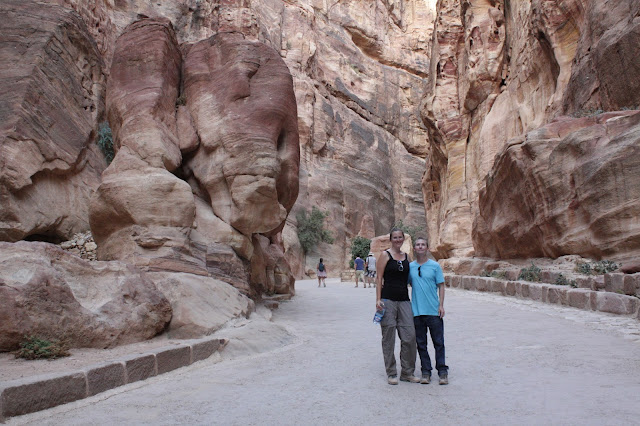 |
| The Siq, a slot canyon with a paved road that acts as the main entrance into Petra. |
 |
| The trail to the High Place of Sacrifice, more like several sets of stairs than a trail. |
The Nabateans were not just rich, they were also smart. The only entrance into the Petra valley is through a slot canyon called the Siq. Walls of the Siq are hundreds of feet high yet only fifteen feet wide in spots. At over a half a mile long, its winding path was a perfect deterrence for possible invading armies. Visitors today must still walk the length of the Siq while dodging horse-drawn carriages to enter into the city of stone.
 |
| The view of facades from the end of the trail to the High Place of Sacrifice. We had to walk another few minutes past the sacrifice structures to get the awesome view. Below are the structures at the end of the Siq that visitors can walk into. |
The Siq ends at the building called the Treasury (it is not actually known what the purpose of this building was). The treasury is one of the largest if not the most ornate facade in Petra. It was made famous by Indiana Jones and the last Crusade as the place where he discovered the Holy Grail. Only the exterior was featured in the movie as the inside is just one medium sizeish room lacking ornamentation. The lack of interior decoration is true of most of the facades in Petra. Recent excavations indicate the Treasury was probably a tomb, much like most of the other facades in Petra. In reality what remains of Petra is more for the dead than for the living.
 |
| The view from the High Place of Sacrifice contains the entire valley, not just the Sirque. |
We only had one day to explore Petra. Wanting to make the most of it we decide to hike both the trail to the High Place of Sacrifice and the Monastery. An undertaking in nice weather we commenced our hikes in 100+ degree heat, toating liters of water. The hike to the High Place of Sacrifice more often resembles a series of stairs than a trail, winding its way up the cliffs to the platform above the ancient city. At the top are the remains of a courtyard (which is surprisingly hard to find) where animals were sacrificed to the Nabatean Gods, equipped with drainage channels and basins to collect the animal's blood. A few more minutes walk past the sacrificial courtyard opens up to a view of the entire valley, which made the sweaty sweaty hike 100% worth it.
The Renaissance Tomb accessible via the backside of the High Place of Sacrifice Trail. It contains empty tombs in the floor from which bodies were excavated.
We had to back track a bit from the amazing view to find the trail again, which we continued on down the opposite side of the mountain from which we came. I saw other hikers retreat from the High place of Sacrifice from the direction we came from which was a mistake, as my favorite part of the entire site, was the backside of the trail which curves and loops down to the valley below. This area of Petra was uninhabited by other tourists. I did not see a single other tourist on the backside trail. Also, it abounds with beautiful facades which can be entered (unlike the Treasury and Monastery) one of which (the Colored Triclinium) was carved on the inside.
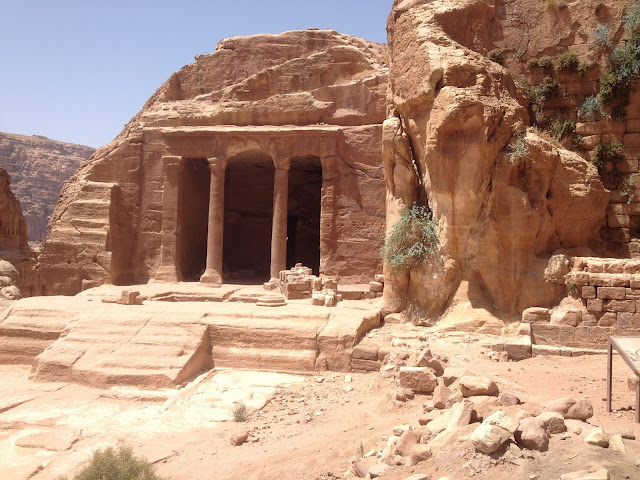 |
| The Garden Temple near the Renaissance Tomb. It once had a water cistern that continually watered a lush garden. |
Aside from the Triclinium, the Roman Tomb so named for the carving of a Roman solider on the front, Renaissance Tomb, Garden Temple, and Lion Head Monument can all be enjoyed in peace and quite away from the crowds on the backside of the High Place of Sacrifice Trail. I will not that the backside of this trail is much less well maintained than the more frequented front side. Many of the stairs originally carved into sandstone and not reinforced have eroded down to nubs or turned entire sections of stairways into slick ramps. As someone afraid of heights, I did not enjoy hiking down this steep and slick path, but the rewards were worth the discomfort.
 |
| The Colored Triclinium at Petra is the only interior with actual decorations. Beautiful and colorful sandstone rock provides the canvas from which columns were carved. This tomb is slightly downhill from the Garden Temple. |
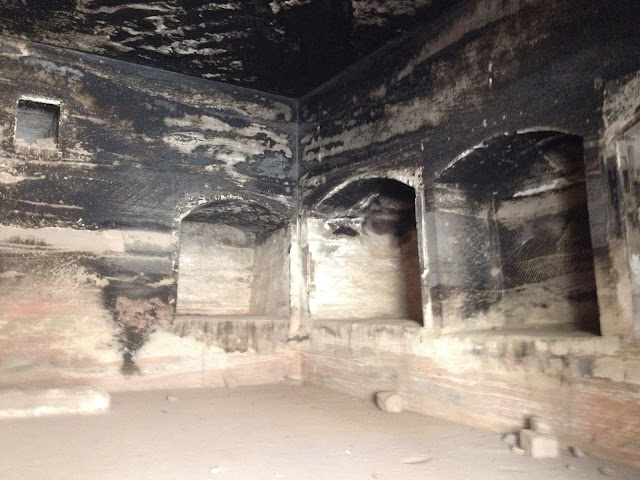 |
| Part of the interior of the Tomb of the Roman Solider. This tomb is the only one with a a second smaller room (not shown). No light pierces the second room making it dark and a little creepy. |
 |
| The Lion Head Monument near the Temple Garden. Unfortunately only the teeth have survived. |
After our hike down into the valley, we enjoyed lunch at a buffet restaurant within the valley, which had some of the best fresh falafel I have ever had. Considering at this point I have been in the Middle East for almost two months, I think that statements holds credit. After packing away two plates of falafel and purchasing a few more liters of water, we made our way up another series of stairs on our hike to the Monastery. The largest individual structure of Petra, and set apart from all the others by several hundred stairs, the Monastery lacks the exquisite and detailed decorations that adorn most of the other buildings. Despite its lack of detail, the building is still impressive, if only for its size alone. Unlike most of the other buildings in Petra which have arbitrary names since no one knows what their purpose was, the Monastery was at one time actually used as a monastery and a church at different points in time. We spent more time gazing at this structure than any other in Petra, probably due to the comfy couches and cold drinks amiable in the plateau shade opposite the structure.
 |
| The Monastery, so named because it was used as a monastery during the Byzantine era (think Crusades) is one of the largest facades at Petra. It is unique in that it is set apart from the other facades atop a mountain. |
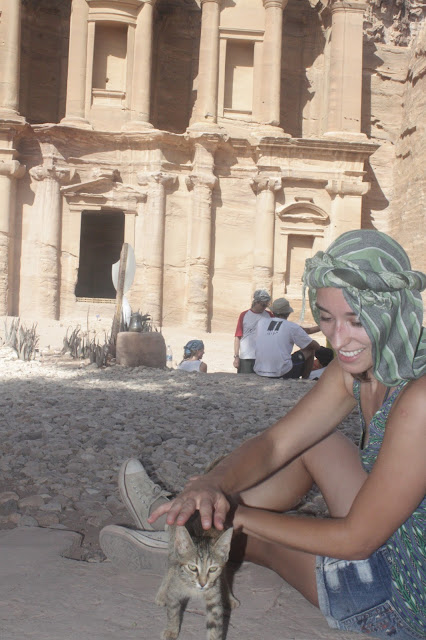 |
| Stray cats amass at the Monastery and this kitten checks out my friend Ana. |
Running out of energy and out of daylight, after our break at the Monastery we rushed back down into the valley in an effort to see as many of the remaining structures as we could before needing to meet our tour guide to pick up our luggage. So many cultures interacted with and inhabited Petra. After the fall of the Nabatean empire due to lost battles and subsequent assimilation in Greco-Roman culture Nabateans stopped carving into stone so much and began building churches and halls in the Roman style free-standing from the cliffs.
 |
| One side of the Street of Facades, with tomb upon tomb. |
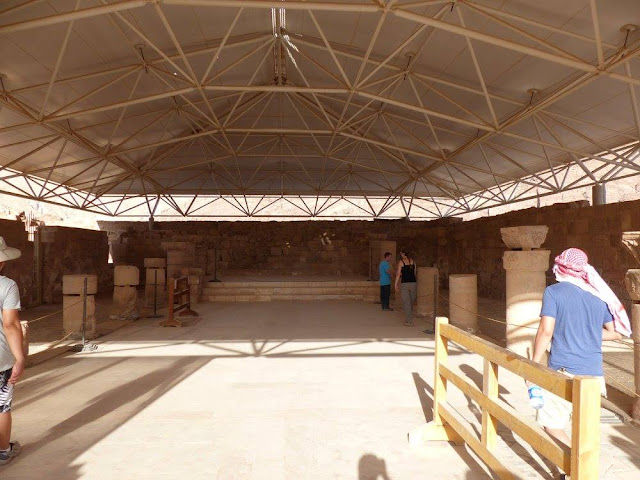 |
| The inside remnants of a Roman Church in the Petra valley. |
What remains of the Romans are mostly impressive floor mosaics, roads, and the bottom half of columns that once supported buildings. Earthquakes brought most of the Roman structures to ruin, but the facades carved directly into the cliffs by the Nabateans remain, defiant against their conquerers and against time. After the Nabateans were eventually driven into peasantry by their tribal Arab neighbors, Petra was abandoned and not reintroduced to the world until 1812 by the Swiss.
 |
| Roman mosaics of animals on the church floor. |
Despite being a vast city, Petra is extremely well hidden. As is apparent from any of the overlooks of Petra on the drive in, Petra is hidden within the walls of canyons and valleys that cannot be peered into from afar. Unless passersby stood directly on the edge of an over-looking cliff, they would see nothing but a barren landscape, making Petra not just a city of the dead or city of stone, but also a hidden city.
 |
| Petra from above. The city is hidden in the canyons below away from prying eyes. |
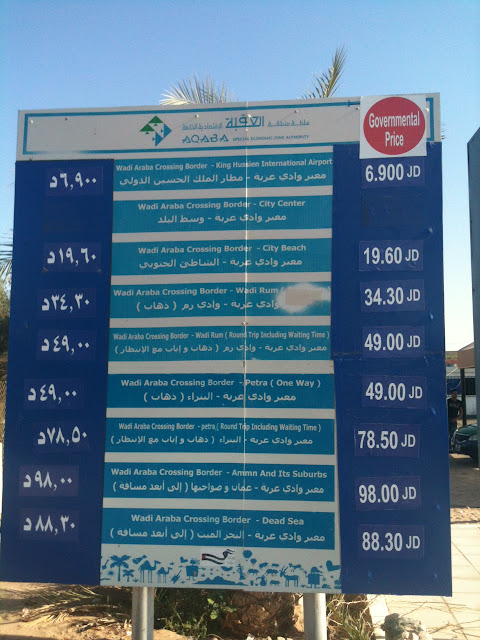 |
| A sign at the Israel-Jordan border crossing showing the price of taxi rides to various tourist destinations. |














No comments:
Post a Comment